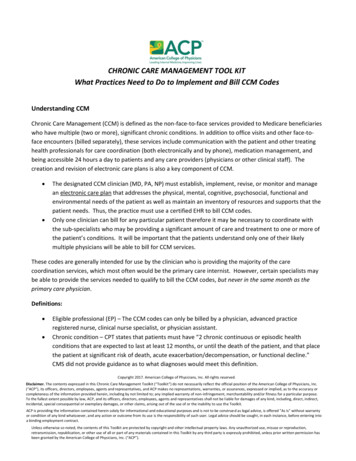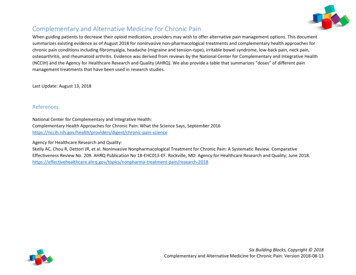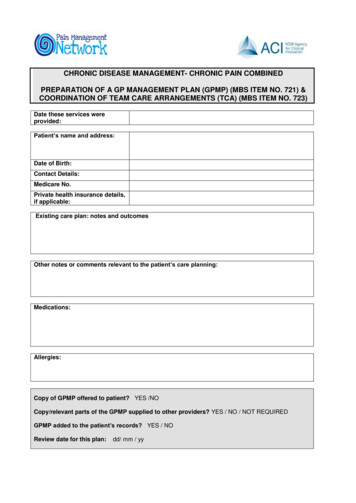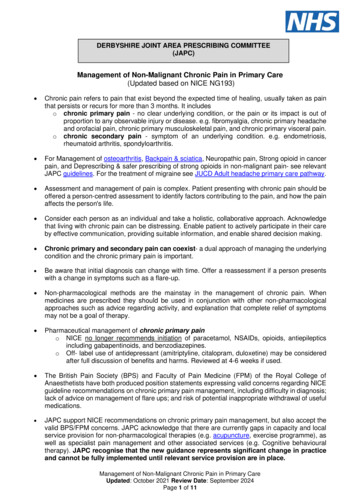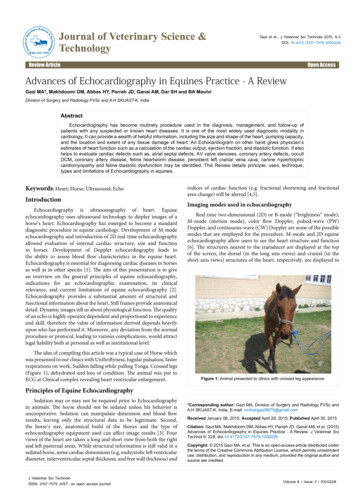
Transcription
Managing Equines with chronic sacroiliac dysfunction: incorporatingsuggestive exercisesBy Gemma Key Veterinary Physiotherapist Adv Cert Vet Phys, Cert Ed Clinn AccMiddx, MRAMP. MIRVAPSacroiliac disease or dysfunction is a very complex issue when it comes to diagnosing andmanaging this condition within the equine patient.The AnatomyThe Pelvis is made up of three bones which are fused, the Ilium, the ischium and the pubis.The lower part of the horses back is made up of 5 fused vertebrae, called the Sacrum. Thesacroiliac joint is the synovial articulation between the ventral wing of the ilium and thedorsal wing of the sacrum. The role of the sacroiliac joint is to transfer forces and propulsionfrom the hindlimbs to the spine and to add stability. This allows the horse to drive forwardand supports the caudal vertebral column. The sacroiliac joint is supported by the ventral,dorsal, sacrosciatic and interosseous ligaments.Causes of Sacroiliac disease or dysfunctionThere can be a number of reasons as to why the equine patient develops a sacroiliacdysfunction. These can include. Trauma such as falling at high speed, falling during transportation, rearing and fallingover backwards, sitting down like a dog, pelvic trauma from injury inflicted by otherequines.Chronic repetition placing stresses on the joint and associated ligaments such asracing, show jumping, eventing. Noted in performance horses.Presenting Signs Reluctance to go forward
Decrease in performanceLack of impulsionStilted and stiff canter with bunny hop actionIntermittent hind limb lameness (not always present)Poor lateral workPoor hindlimb engagementBuckingRefusing fences or rushingUnequal hindlimb musculaturePain on palpation around the associated area.Heat/inflammation if more of an acute traumaCan be difficult for the farrier.DiagnosisThe main two diagnostic tools used in the case of SI dysfunction are scintigraphy bonescanning and rectal ultrasonography scanning. The function of these are to highlight anychanges in the ligament fibre patterns such as stretched, torn, thickened and any bonychanges such as arthritis.It must also be remembered these horses may well be altering the way they move due tolower limb orthopaedic pathology, hence putting strain on the sacroiliac region and causingthe ligaments to be put under strain. This can include Stifle pain, Tarsocrural pain, proximalsuspensory pain and these need to be ruled out at the same time, particularly if the horse ispresenting with a hindlimb lameness.TreatmentIf dealing with an acute injury, the most important thing is rest and look to reduce anyinflammation present. This would normally present with an acute onset andheat/inflammation around the area. Once any risk of pelvic fracture has been ruled out,then you can start with intensive physiotherapy. The short term goal is pain relief, reduceinflammation and maintain function and stability. The more long term goal is to prevent theacute injury from becoming a chronic dysfunction.If a chronic dysfunction is apparent treatment can consist of the below Pulsed Electronic Magnetic TherapyIntra articular medication to support the joint and associated ligaments and providepain reliefHwave therapy can be useful for pain relief and muscle stimulation. I normally find 4sessions a week apart can be useful. Particularly in horses that do not receivecorticosteroid medication into the areaDevising a core training and strengthening routine, particularly suited to encouragethe horse to improve their stability and support of the vertebral column and pelvicregion.
Stretch routine including baited stretches, it is worth also making sure the horsedoes not have any cranial, cervical abnormalities as I am also seeing more horseswith a link between cervical abnormalities and SI dysfunctionLook at amino acid supplement such as Equitop Myoplast or Optimuscle to aid themusculature to support the ligaments and bones within the pelvic region. This workswell alongside a designated exercise regime.Case StudyGeorge 11yo Ex Racer 16.1hh TB Gelding. Came out of racing as an 8-year-old and was thenpassed from home to home in poor condition.Was purchased by my client 9 months ago in very poor condition, underweight, undermuscled, crib biter.Initially presented with an inability to put weight on, right hind circumduction. Lowerthoraco lumbar discomfort, poor hoof condition, loaded thoracic sling with very hypertonicmusculature and significant over development of the ventral musculature.Did not like having his saddle on and was initially suspected of having Equine Gastric Ulcersyndrome although he scoped clear. He was investigated by their veterinary surgeon whodiagnosed George with a mild right hindlimb lameness with mild radiographic changes in hisdistal tarsal joint. However, scintigraphy and rectal ultrasound scanning revealed wear andtear in the ventral aspect of his SI, with bony changes and ligament desmopathy, morenoted on the left side.Treatment Plan Intra articular medication of the SI joint with corticosteroidsIntra articular medication of the distal tarsocrural joint
Remedial farriery to give a little more lateral support to aid the foot and limbplacementPulsed magnetic field Therapy daily over the SI regionIn hand ground work consisting of long reining, incorporating a core equiband/TheraBand to aid core stability and abdominal recruitment. Starting off with 15minutes daily followed by the following stretch regime, building up and increasingtime. Avoid too much circle work initially.Lateral Flexion stretches, side to side, to point of shoulder, to fetlock, to girth lineand behind last rib. Hold week one up to 5 seconds, building up to 20 seconds byweek 3. Ideally repeating 3 or 4 times a weekDorsal Ventral stretches, head to between fetlocks and also between carpus. Again,hold for 5 seconds initially, building up to 20 secondsLumbar Sacral stretches, using hindlimb reflex to encourage George to tilt and holdhis pelvis underneath him. Do not use excessive force or quick movement, slowposturally enhancingAbdominal lifts by gentle encouraging George to lift his abdomen. I alternatebetween the lumbar sacral and abdominal liftsGentle weight shifting by rhythmic stabilisation from the sternum to the hind limbs,encouraging George to take a little more weight behind.Hacking and introducing some gentle inclines and different terrain work will help.Just be mindful of too much strain on the SI region with too step an incline anddecline in the initial stages. Looking to increase ridden work over the next couple ofweeksPole exercises can include a selection of the below, these will depend on theindividual and at what stage of the rehabilitation programme they are at 4 walk poles in a line 3 foot apart, start on the ground then build up to raised poles. Reps of5 each rein4 poles end to end and use them to serpentine and weave over them. You can use shallowloops and large loops over the poles. You can also then add another 4 poles side by side tothe other ones, this increases the width angle the horse has to step across5 trot poles 4.5 feet apart. Start on the ground then build up to raised4 canter poles on a large circle on a clock face, so position your poles at 12, 3 6 and 9. Youcan also then raise sides on these, fairly difficult but build up to itRandom scattered poles around, so they have to think about where their feet are. Do notspoon feed them too muchFan of poles, 5 normally, you can use this to alter your stride length, so narrower end willgive you more flexion, wider more extension.Christmas Tree creation using poles is a good exercise too.Labyrinth making a corridor of poles so the horse has to stop and think so imagine 3rectangles making like a Z shape. Useful to do in hand with thisA channel of poles so the horse has to work through them, helps with straightness, startwide then make the channel narrower
4 poles in a square then add another 2 poles on a X in the middle of the square. You canwalk and trot over theseMy main goal for George at present is to increase his muscle mass, his core stability andproprioception and to ensure he is comfortable when asking him to perform any of theabove exercises. It must be noted that whilst these are suggestions to aid and enhancerecovery, each case is individual and will need to be adapted to suit each horse.For any further information or graduate mentoring/clinic days please contact meGemma KeyTel 078066 38473 or Gemmakey61@yahoo.comwww.gemmakeyvetphysio.com
distal tarsal joint. However, scintigraphy and rectal ultrasound scanning revealed wear and tear in the ventral aspect of his SI, with bony changes and ligament desmopathy, more noted on the left side. Treatment Plan Intra articular medication of the SI joint with corticosteroids Intra articular medication of the distal tarsocrural joint




